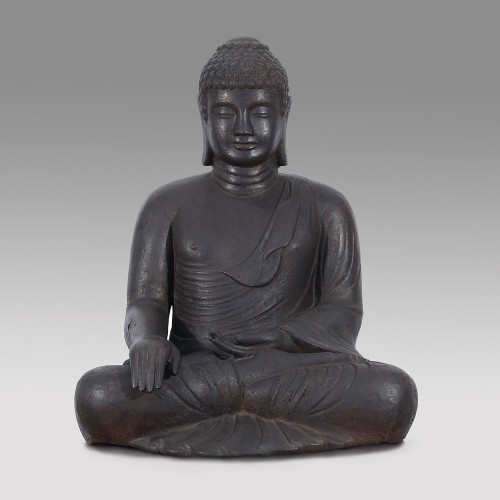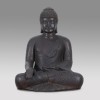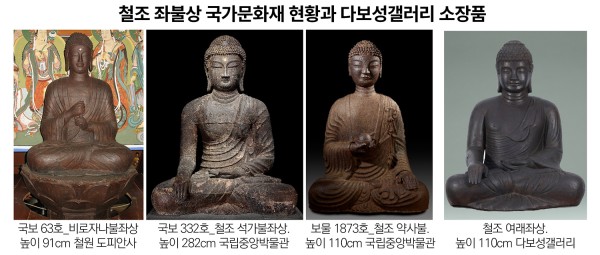본문
철로 만들어진 철조 여래좌상입니다. 우리나라에서 이와 같은 철불좌상은 통일신라 말부터 제작되기 시작해 고려시대에 널리 유행하였습니다.
철불은 정교하고 화려하게 장식된 청동불에 비해 거칠고 토속적인 성격이 강한 특징이 있습니다.
높이 110㎝의 거대한 이 철불좌상은 작은 소라 모양 머리카락인 나발(螺發)의 정수리에 상투 모양인 육계가 붙어 있습니다. 왼쪽 어깨 위에 걸친 가사는 부드럽게 주름지면서 복부로 펼쳐지며 편단우견(偏袒右肩)으로 오른쪽 어깨를 드러내었고, 오른손은 땅을 가리키면서 왼손은 무릎 위에 올려 바닥을 보이게 하는 '항마촉지인'(降魔觸地印)의 수인(手印)을 맺은 채 반가부좌를 하고 있는 모습입니다.
이러한 머리모양과 큼직한 육계, 잘 정돈된 안면, 오른쪽 어깨를 드러내고 옷자락을 늘어뜨린 선 등의 뛰어난 표현은 통일신라 전통을 충실히 반영했다고 할 수 있습니다.
━━━━━
这是三国时代的铁制佛像。在韩国,像这样的铁制佛坐像从统一新罗末期开始制造,在高丽时代广泛流行。
铁佛与精致华丽的青铜佛相比,具有粗糙土俗的特征。
高110厘米的铁佛座像是小海螺模样的螺发,头顶上是发髻模样的肉髻。左肩上的袈裟呈皱纹叠加,向腹部展开。身穿袒右肩袈裟,露出右肩。右手触地,左手横放膝盖上,施降魔触地印,结跏跌坐。与韩国石窟庵主佛的样子相似。
这样的发型、硕大的肉髻、整齐的面部、露出的右肩、垂下的衣襟等优秀表现,充分反映出统一新罗时期的传统。
━━━━━
This is an iron Buddha statue in the Three Kingdoms period. This kind of statue was made in the late unified Silla and became widely popular in the Goryeo era.
Compared with the exquisite and gorgeous bronze Buddha statue, the iron Buddha statue is rough and vulgar.
This 110cm Buddha statue has a bun on its head made of small conch-like hair. The clothes on the left shoulder form soft wrinkles, revealing the right shoulder. His right hand is pointing below to the earth and the left hand is making a sign, which is similar to Seokguram's main Buddha statue.
This shape is one of the good examples of the Buddhist tradition of Unified Silla.


